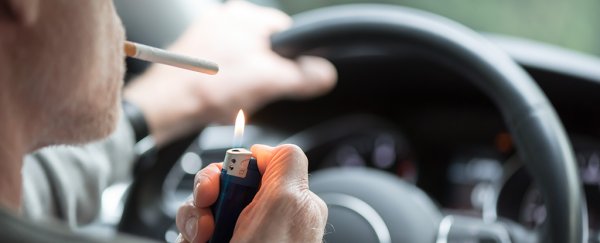Links between disease and tobacco have been clear for half a century now, while the harmful effects of second-hand 'passive' smoking have been studied since the mid-1980s.
Now we have reason to suspect that the residue left behind by the aerosols from cigarettes on clothing and furniture can continue to affect our health, making third-hand smoke a health risk we need to start paying attention to.
You don't need us to tell you smoking isn't exactly the healthy hobby once claimed by tobacco companies (and the occasional unscrupulous physician).
With as many as one in five deaths in the US now attributed to long term smoking, the debate over whether the additives and natural components of dried tobacco that hit the lungs can damage our cells and biochemistry is a settled one.
The consequences of passive smoking – inhaling the smoke particles that permeates the surrounding air – can also be rather nasty, being linked with a whole list of health conditions including coronary and lung disease, lung cancer, SIDS, asthma, and ear infections in children.
Since second hand smoke isn't something we necessarily volunteer to breathe in, many governments have taken to banning smoking in an increasing number of public areas.
Now we might need to consider how far the health impacts of those cigarette toxins reach, with a growing pile of evidence suggesting even once the air has cleared, the chemicals left by cigarettes continue to be problem.
In third-hand smoke (THS), particles coming directly from burning tobacco and exhaled smoke tend to accumulate on surfaces such as clothing, furniture, and hair. Anybody who has come home after a night out at a smoke-friendly venue would know the fragrance of THS.
These particles are more than just a need to reach for deodoriser – if they accumulate over time they can react with the air to form new carcinogens such as compounds of nitrosamine.
Having evidence of carcinogens hanging about in an environment is one thing. Now we have reason to think it doesn't take very long for those chemicals to be actually doing some damage.
"Our goal was to determine the minimum amount of time required to cause physiological changes in mice when they are exposed to THS, using an exposure system that mimics human exposure," says researcher Manuela Martins-Green from the University of California, Riverside.
By placing various materials dosed with cigarette smoke in with caged mice, the research team was able to mimic the effects of an environment heavy with THS.
Over the following six months, the mice had brain, liver, and serum samples taken for testing.
The researchers looked at hormonal changes, insulin resistance, metabolic effects, and any signs of damage to liver and nervous tissues.
It didn't take long for them to notice an effect.
"We found that THS exposure as early as one month resulted in liver damage," says Martins-Green.
"THS exposure for two months resulted in further molecular damage, and at four to six months caused even more such damage. We also found that the mice showed insulin resistance after long-term THS exposure."
Since the liver serves as the body's cleaning station, chemicals that impede its function could potentially increase in toxicity in an increasingly destructive cycle.
The researchers also noticed a steady increase in stress hormones over the duration of the study, leading to immune fatigue that also risked further damage.
It's important to emphasise that the research was conducted on mice under ideal laboratory conditions. The real world isn't as neat and people aren't tiny rodents.
Still, it's a good opportunity to consider the potential risks, especially as the links continue to gain strength.
In spite of regulations that attempt to curb where and when people can smoke, home environments are still places where people freely light up.
With aerosols clinging to carpets, clothing, and couch fabric, THS could be regarded as the new silent killer for children who touch these surfaces on a regular basis.
"Although our research was not done on humans, people should be aware that hotel rooms, cars, and homes that were occupied by smokers are very likely to be contaminated with THS," says Martins-Green.
It's always a good time to quit smoking. Now any season is also a good time for a spring clean.
This research was published in Clinical Science.
